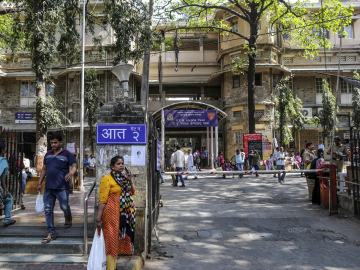Child Diarrhea Has a Cheap and Easy Fix—Why Isn’t It Reaching Patients?
Diarrhea kills 500,000 children under five every year worldwide. Most of those deaths could be prevented with an inexpensive go-to treatment: Oral rehydration salts that target severe dehydration caused by diarrhea, which can become fatal within a matter of hours. Yet the WHO’s recommended standard of care for child diarrhea—a small package of electrolytes mixed with water before drinking—is underused.
Currently, nearly half of diarrhea cases around the world do not receive ORS, according to a new study published in Science. Looking at two regions in India, researchers from RAND, the University of Southern California, Duke University, and the Indian Institute of Management aimed to figure out why.
The team enlisted actors posing as child caregivers to visit over 2,282 private health providers with a hypothetical case of a two-year-old child with diarrhea, but no sign of a bacterial infection that might require antibiotics. The study also surveyed 1,200 child caregivers about their own care preferences.
They found that providers’ perceptions that caregivers did not want ORS trumped their own views on the medication, and explained 42% of under-prescribing. Product stockouts and financial incentives to prescribe other products explained only 6% and 5% of under-prescribing, respectively.
Zachary Wagner, PhD, the study’s lead author and an economist at RAND, spoke with GHN about what can be done to help ORS reach more patients.
What was the impetus for this study?
We’ve seen in our prior work that providers often don't recommend ORS for cases of diarrhea when they seek treatment. But it's not that providers don't know what the right thing is. It's that they know what the right thing is, but they still aren't doing it. That's the conundrum that we started with.
What were the potential reasons why ORS is under-prescribed?
We thought the disconnect might be driven by three factors.
- ORS is cheap—about $0.15 for a 2-packet treatment course—so private providers might prefer to push something more expensive like antibiotics.
- Caregivers might not want ORS, and so providers might not give it to them, or the providers thinks that ORS isn't something that caregivers want from them.
- Stock-outs. If ORS isn’t available, providers might suggest something else instead.
What we found is that of the three factors, perceived preferences of a child’s caregiver were really the most important. When caregivers expressed a preference for ORS, they were twice as likely to get it compared to those who expressed a preference for antibiotics, or no preference.
Why do you think that is?
It’s not as simple as caregivers not wanting ORS. When asked, caregivers said ORS was their preferred treatment for child diarrhea—they just don't express that preference to the provider. There seems to be a disconnect between what providers think caregivers want and what they actually want, and that is driving the problem.
What’s driving this disconnect?
We've found that providers often view ORS as a supplement rather than a medicine, and they assume that caregivers are coming to them looking for something stronger—like antibiotics. Antibiotics are inappropriate for most cases of child diarrhea, but that's the most common thing that's dispensed. In our sample, 70% of cases were prescribed antibiotics.
Another possible deterrent from prescribing ORS is that it doesn’t treat diarrhea symptoms. ORS treats dehydration and prevents severe dehydration, that’s not something that you can really see happen. Antibiotics and other medicines can prevent the symptoms from occurring.
Why isn’t ORS prescribed alongside antibiotics?
One possibility that's been discussed in other work is that providers are often mistrusted, and they want to avoid patients feeling like they’re being upsold, so often they often only prescribe one medicine rather than multiple. There’s a recent paper that documents that phenomenon in detail.
How can health providers engage differently with caregivers to better understand what they want?
It's important to change providers’ perceptions of patient preferences, either [by] getting more caregivers to express a preference for ORS, or by targeting providers directly and telling them that more people want ORS than they think.
One possibility is having posters in providers’ offices that advise caregivers to request ORS for diarrhea. [And] in an upcoming study, we will test out bypassing providers and distributing ORS directly to households to have on hand.
Do these findings from India have implications for other countries?
ORS is underused in most settings where diarrhea is prevalent.
To find out whether the same mechanisms lead providers to under-prescribe ORS outside of India, we’d have to replicate the study. But based on the underlying characteristics, there's a lot of commonalities between care seeking and treatment for child diarrhea in South Asia and sub-Saharan Africa, where diarrhea prevalence is much higher. Increasing ORS is going to save more lives there.
Why was it important to conduct this study using actors? Did you have an open-call audition?
We started with about 40 people who did a role-playing exercise with the real doctors, [and] 25 of them made the cut. They had to memorize certain responses to questions, but it was a pretty easy role to play because most of them lived in the area and were essentially playing themselves.
By using actors—or standardized patients—we can ensure everything about the case presented was identical aside from the preferences expressed. This method is now considered the gold standard in measuring quality of care, especially in primary care settings in LMICs, where we do not have administrative data.
Join the 50,000+ subscribers in 170+ countries who rely on Global Health NOW summaries and exclusive articles for the latest public health news. Sign up for our free weekday newsletter, and please share the link with friends and colleagues.
Sahil, a 7-month-old child suffering from diarrhea, lies in a bed at the district hospital on May 21, 2022, in Mirzapur, Uttar Pradesh, India. Ritesh Shukla/Getty Images





